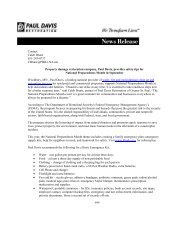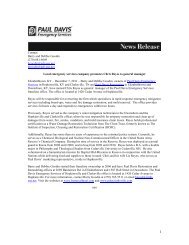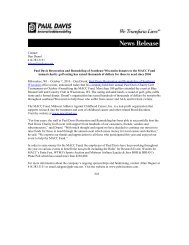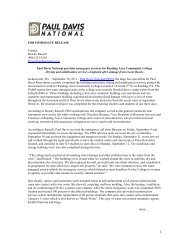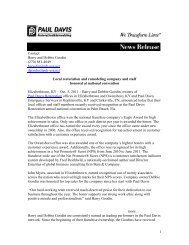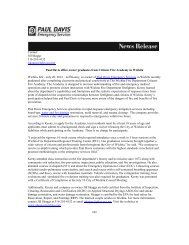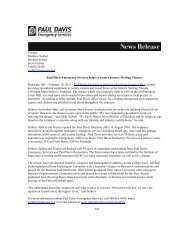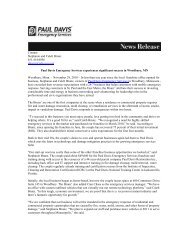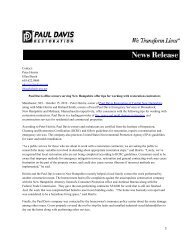Contact: Peter Hoiriis 603.622.9800 phoiriis@pdrnh.com Paul Davis ...
Contact: Peter Hoiriis 603.622.9800 phoiriis@pdrnh.com Paul Davis ...
Contact: Peter Hoiriis 603.622.9800 phoiriis@pdrnh.com Paul Davis ...
You also want an ePaper? Increase the reach of your titles
YUMPU automatically turns print PDFs into web optimized ePapers that Google loves.
<strong>Contact</strong>:<br />
<strong>Peter</strong> <strong>Hoiriis</strong><br />
<strong>603.622.9800</strong><br />
<strong>phoiriis@pdrnh</strong>.<strong>com</strong><br />
<strong>Paul</strong> <strong>Davis</strong> Restoration office owners provide tips for puff back damage<br />
-Puff backs can happen to anyone who heats their home or office with oil or gas-<br />
Manchester, NH – October 18, 2010 - <strong>Peter</strong> <strong>Hoiriis</strong>, owner of <strong>Paul</strong> <strong>Davis</strong> Restoration of Central New<br />
Hampshire, and Mike <strong>Hoiriis</strong> and Richard Smith, owners of local <strong>Paul</strong> <strong>Davis</strong> Emergency Services in<br />
Monadnock, New Hampshire and Methuen, Massachusetts respectively, offer the following tips for<br />
homeowners and business owners who experience puff back with their oil or gas heating systems.<br />
According to <strong>Peter</strong> <strong>Hoiriis</strong>, a puff back can occur when a furnace turns on and excess fuel is quickly<br />
ignited. The ignition creates a small explosion and can frequently cause soot to travel through the heating<br />
system and be distributed throughout the home or business.<br />
<strong>Paul</strong> <strong>Davis</strong> is a leading provider of fire, water and mold damage restoration, and reconstruction services for<br />
residential and <strong>com</strong>mercial properties.<br />
“Damage from puff back can appear in a wide variety of ways,” said <strong>Hoiriis</strong>. “For example, the damage<br />
may look like dust that reappears after cleaning or smearing on various surfaces, dark fingerprints that<br />
appear on almost every surface along with ‘soot webs’ that look like regular cobwebs, but are darker and<br />
soot around heating ducks and electrical circuits,” he explained.<br />
According to <strong>Hoiriis</strong>, if a puff back has occurred, then don’t attempt to clean carpets, upholstered furniture,<br />
wallpaper or flat-painted walls. “Incorrect cleaning from damage do to a puff back will <strong>com</strong>pound the<br />
problem. Avoid touching anything. Soot on your hands can permeate upholstery, walls, and woodwork and<br />
make things much worse,” he said. <strong>Hoiriis</strong> re<strong>com</strong>mends that home and business owners consider notifying<br />
their insurance agency or insurance <strong>com</strong>pany immediately for next steps that may include remediation and<br />
clean up.<br />
<strong>Hoiriis</strong> re<strong>com</strong>mends working with a restoration contractor who is experienced in puff back mitigation as<br />
soon as possible. “It is important that the cleaning process begins immediately to prevent further damage<br />
and limit insurance claim amounts,” he said. “Within hours, acid residue will stain grout, fiber glass<br />
fixtures and Formica countertops. Also, appliances and vinyl windows will begin to discolor as well as<br />
finishes on furniture. Within days, metals will be<strong>com</strong>e corroded and pitted, walls yellow permanently.<br />
Within weeks Crystal, glass and china may be<strong>com</strong>e permanently damaged from etching. Carpet fibers<br />
yellow permanently,” he said.<br />
The most <strong>com</strong>mon cause for puff back is excess fuel in the bottom of the furnace and firebox, clogged<br />
orifices in the furnace burner nozzle that results in delayed ignition or a heavy build-up of soot within the<br />
burner. Puff backs happen most frequently in old fired furnaces and can also occur in a gas heating system.<br />
Additionally, in a forced hot air system, the ignition explosion can shake loose and blow out any soot or<br />
soil that has accumulated in the ductwork, further contributing to the severity of the loss. Puff back usually<br />
occurs when the furnace is turned on for the first time in the fall or during the start of cold weather.<br />
1
“Home and business owners can reduce the risk of a puff back by having their furnace inspected annually<br />
and maintained in good repair. Keep debris, animal hair or anything that could interfere with the furnace<br />
and its proper functioning away from your oil burner,” said <strong>Hoiriis</strong>.<br />
<strong>Paul</strong> <strong>Davis</strong> Restoration of Central New Hampshire has specially-trained technicians who use the latest in<br />
“green” and non toxic cleaning technology and techniques to repair and restore the damage caused by puff<br />
backs. Technicians are skilled at treating contents such as carpets, clothing, drapery, furniture and other<br />
items using sophisticated ozone equipment and dry cleaning to thoroughly remove the stains and odors<br />
associated with puff backs and other fire-related damage.<br />
“We do all of our cleaning for soot and smoke mitigation with natural non toxic cleaners. We understand<br />
that most people who need our services in central New Hampshire now prefer and some require us to use<br />
non toxic cleaning solutions,” said <strong>Hoiriis</strong>. “We personally don’t like to use harsh toxic chemicals in our<br />
own home and strive to educate our customers about the benefits of cleaning with non toxic solutions for<br />
puff back damage and other restoration and cleaning services.”<br />
<strong>Hoiriis</strong> and his full-time staff are certified from the Institute of Inspection, Cleaning and Restoration<br />
Certification (IICRC) in water, mold and fire along with certifications in Applied Structural Drying (ASD).<br />
For more information, contact <strong>Paul</strong> <strong>Davis</strong> Restoration at <strong>603.622.9800</strong> or email phoiriis@pdr-usa.net. Visit<br />
the website at www.pdrnh.<strong>com</strong>.<br />
###<br />
<strong>Paul</strong> <strong>Davis</strong> Restoration, Inc. is a leading provider of fire, water and mold damage restoration, and<br />
reconstruction services for residential and <strong>com</strong>mercial properties. Founded in 1966, <strong>Paul</strong> <strong>Davis</strong> Restoration<br />
has franchise office locations throughout the US. Visit the website at www.pdrestoration.<strong>com</strong> .<br />
2



